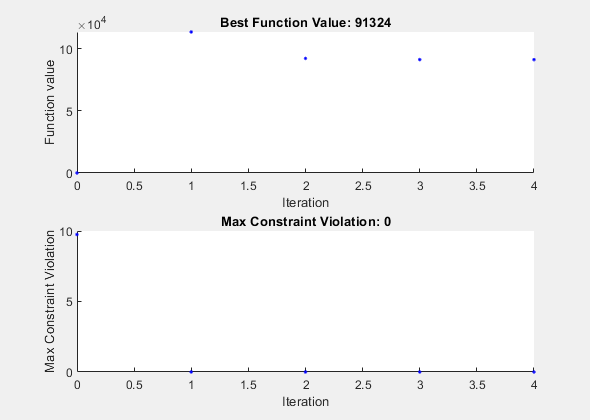Constrained Minimization Using Pattern Search, Solver-Based
This example shows how to minimize an objective function, subject to nonlinear inequality constraints and bounds, using pattern search. For a problem-based version of this example, seeConstrained Minimization Using Pattern Search, Problem-Based.
Constrained Minimization Problem
For this problem, the objective function to minimize is a simple function of a 2-D variablex.
simple_objective(x) = (4 - 2.1*x(1)^2 + x(1)^4/3)*x(1)^2 + x(1)*x(2) + (-4 + 4*x(2)^2)*x(2)^2;
This function is known as "cam," as described in L.C.W. Dixon and G.P. Szego [1].
Additionally, the problem has nonlinear constraints and bounds.
x(1)*x(2) + x(1) - x(2) + 1.5 <= 0 (nonlinear constraint) 10 - x(1)*x(2) <= 0 (nonlinear constraint) 0 <= x(1) <= 1 (bound) 0 <= x(2) <= 13 (bound)
Code the Objective Function
Create a MATLAB® file namedsimple_objective.mcontaining the following code:
typesimple_objective
function y = simple_objective(x) %SIMPLE_OBJECTIVE Objective function for PATTERNSEARCH solver % Copyright 2004 The MathWorks, Inc. x1 = x(1); x2 = x(2); y = (4-2.1.*x1.^2+x1.^4./3).*x1.^2+x1.*x2+(-4+4.*x2.^2).*x2.^2;
Solvers such aspatternsearchaccept a single inputx, wherexhas as many elements as the number of variables in the problem. The objective function computes the scalar value of the objective function and returns it in its single output argumenty.
Coding the Constraint Function
创建一个MATLAB文件命名simple_constraint.mcontaining the following code:
typesimple_constraint
function [c, ceq] = simple_constraint(x) %SIMPLE_CONSTRAINT Nonlinear inequality constraints. % Copyright 2005-2007 The MathWorks, Inc. c = [1.5 + x(1)*x(2) + x(1) - x(2); -x(1)*x(2) + 10]; % No nonlinear equality constraints: ceq = [];
The constraint function computes the values of all the inequality and equality constraints and returns the vectorscandceq, respectively. The value ofcrepresents nonlinear inequality constraints that the solver attempts to make less than or equal to zero. The value ofceqrepresents nonlinear equality constraints that the solver attempts to make equal to zero. This example has no nonlinear equality constraints, soceq = []. For details, seeNonlinear Constraints.
Minimize Usingpatternsearch
Specify the objective function as a function handle.
ObjectiveFunction = @simple_objective;
Specify the problem bounds.
lb = [0 0];% Lower boundsub = [1 13];% Upper bounds
Specify the nonlinear constraint function as a function handle.
ConstraintFunction = @simple_constraint;
Specify an initial point for the solver.
x0 = [0.5 0.5];% Starting point
Call the solver, requesting the optimal pointxand the function value at the optimal pointfval.
[x,fval] = patternsearch(ObjectiveFunction,x0,[],[],[],[],lb,ub,...ConstraintFunction)
Optimization terminated: mesh size less than options.MeshTolerance and constraint violation is less than options.ConstraintTolerance.
x =1×20.8122 - 12.3122
fval = 9.1324e+04
Add Visualization
To observe the solver's progress, specify options that select two plot functions. The plot functionpsplotbestfplots the best objective function value at every iteration, and the plot functionpsplotmaxconstrplots the maximum constraint violation at every iteration. Set these two plot functions in a cell array. Also, display information about the solver's progress in the Command Window by setting theDisplayoption to'iter'.
options = optimoptions(@patternsearch,'PlotFcn',{@psplotbestf,@psplotmaxconstr},...'Display','iter');
Run the solver, including theoptionsargument.
[x,fval] = patternsearch(ObjectiveFunction,x0,[],[],[],[],lb,ub,...ConstraintFunction,options)
Max Iter Func-count f(x) Constraint MeshSize Method 0 1 0.373958 9.75 0.9086 1 18 113581 1.617e-10 0.001 Increase penalty 2 148 92267 0 1e-05 Increase penalty 3 374 91333.2 0 1e-07 Increase penalty 4 639 91324 0 1e-09 Increase penalty Optimization terminated: mesh size less than options.MeshTolerance and constraint violation is less than options.ConstraintTolerance.

x =1×20.8122 - 12.3122
fval = 9.1324e+04
Nonlinear constraints causepatternsearchto solve many subproblems at each iteration. As shown in both the plots and the iterative display, the solution process has few iterations. However, theFunc-count列in the iterative display shows many function evaluations per iteration. Both the plots and the iterative display show that the initial point is infeasible, and that the objective function is low at the initial point. During the solution process, the objective function value initially increases, then decreases to its final value.
References
[1] Dixon, L. C. W., and G .P. Szego (eds.).对全球优化2。North-Holland: Elsevier Science Ltd., Amsterdam, 1978.
